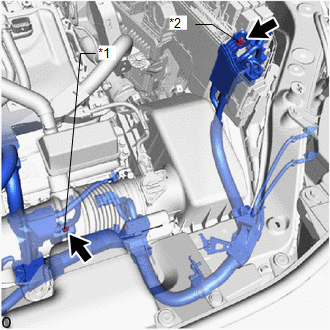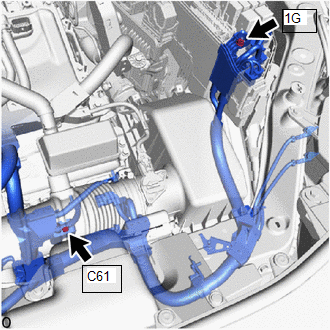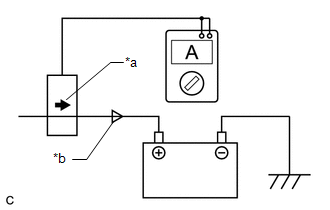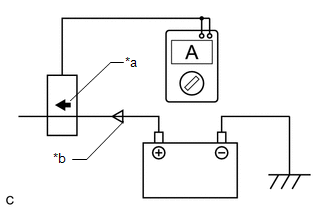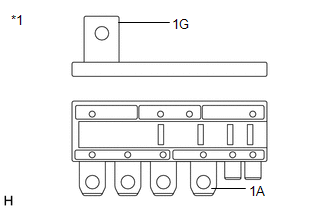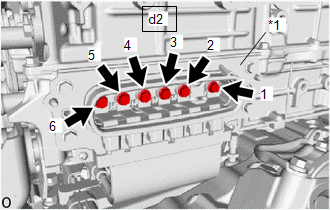| Last Modified: 01-30-2024 | 6.11:8.1.0 | Doc ID: RM100000001OR0W |
| Model Year Start: 2020 | Model: RAV4 HV | Prod Date Range: [06/2020 - ] |
| Title: HYBRID / BATTERY CONTROL: MOTOR GENERATOR CONTROL SYSTEM (for LITHIUM-ION BATTERY): P1CCC96; DC/DC Converter Enable Component Internal Failure; 2020 - 2024 MY RAV4 HV [06/2020 - ] | ||
|
DTC |
P1CCC96 |
DC/DC Converter Enable Component Internal Failure |
DESCRIPTION
The DC/DC converter converts the DC 259 V of the HV battery into DC 12 V in order to supply power to areas such as the vehicle lighting system, audio system and various ECUs. Additionally, it charges the auxiliary battery.
A transistor bridge circuit initially converts DC 259 V into alternating current, and a transformer lowers the voltage.
The DC/DC converter controls the output voltage in order to keep a constant voltage at the terminals of the auxiliary battery.
Then, it is rectified and smoothed (into direct current) and converted into DC 12 V.
The motor generator control ECU sends a signal to the DC/DC converter to prohibit its control and receives signals indicating a normal or abnormal condition of the 12 V charging system via the NODD signal line.
If the DC/DC converter malfunctions, the vehicle will become inoperative. Therefore, the motor generator control ECU monitors the operation of the DC/DC converter and detects malfunctions.
This DTC is stored when the DC/DC converter circuit has a malfunction or its operation is prohibited by a fail-safe function, or the auxiliary battery voltage drops to 11 V or less with the ignition switch ON (READY).
If a DC/DC converter malfunction occurs, DC/DC converter malfunction signals are sent from the DC/DC converter to the MG ECU via the NODD signal line.
This DTC may also be stored if a malfunction of the inverter cooling system (blockage, inverter water pump malfunction, etc.) or a high-voltage insulation malfunction occurs.
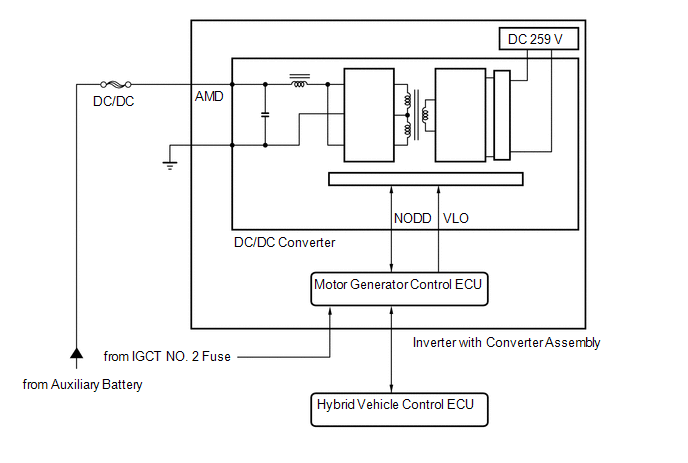
|
DTC No. |
Detection Item |
DTC Detection Condition |
Trouble Area |
MIL |
Warning Indicate |
|---|---|---|---|---|---|
|
P1CCC96 |
DC/DC Converter Enable Component Internal Failure |
Both of the following conditions are met:
(1 trip detection logic) |
|
Does not come on |
Master Warning: Comes on |
HINT:
*: If the DC/DC converter is malfunctioning, its operation and charging will be stopped and the auxiliary battery voltage will drop.
WIRING DIAGRAM
Refer to the wiring diagram for the Generator High-voltage Circuit.
Refer to the wiring diagram for the Motor High-voltage Circuit.
Refer to the wiring diagram for the Rear Motor High-voltage Circuit.
CAUTION / NOTICE / HINT
CAUTION:
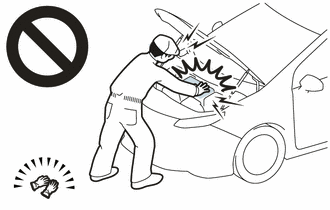
-
Before the following operations are conducted, take precautions to prevent electric shock by turning the ignition switch off, wearing insulated gloves, and removing the service plug grip from HV battery.
- Inspecting the high-voltage system
- Disconnecting the low voltage connector of the inverter with converter assembly
- Disconnecting the low voltage connector of the HV battery
-
To prevent electric shock, make sure to remove the service plug grip to cut off the high voltage circuit before servicing the vehicle.
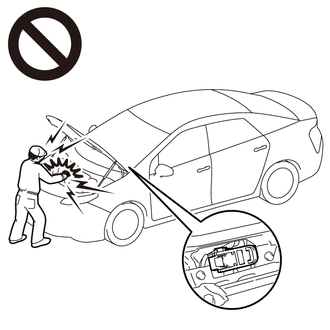
-
After removing the service plug grip from the HV battery, put it in your pocket to prevent other technicians from accidentally reconnecting it while you are working on the high-voltage system.

-
After removing the service plug grip, wait for at least 10 minutes before touching any of the high-voltage connectors or terminals. After waiting for 10 minutes, check the voltage at the terminals in the inspection point in the inverter with converter assembly. The voltage should be 0 V before beginning work.
HINT:
Waiting for at least 10 minutes is required to discharge the high-voltage capacitor inside the inverter with converter assembly.

*a
Without waiting for 10 minutes
NOTICE:
After turning the ignition switch off, waiting time may be required before disconnecting the cable from the negative (-) auxiliary battery terminal. Therefore, make sure to read the disconnecting the cable from the negative (-) auxiliary battery terminal notices before proceeding with work.
HINT:
-
After repair, clear the DTCs, turn the ignition switch off and wait for 30 seconds or more and perform the following procedure to confirm that the auxiliary battery low voltage indicated by this DTC has been repaired.
-
Wait for 2 minutes with the shift lever in P, the ignition switch ON (READY) and the following conditions met, then confirm that Data List item "BATT Voltage (Hybrid control system)" is between 13.0 and 15.0 V.
(If charging is not performed and the electrical load increases, +B voltage may not be steady and will gradually drop.)
- Headlight switch is in the HI position.
- A/C blower fan switch is in the HI position.
- Window defogger switch is turned on.
-
Wait for 2 minutes with the shift lever in P, the ignition switch ON (READY) and the following conditions met, then confirm that Data List item "BATT Voltage (Hybrid control system)" is between 13.0 and 15.0 V.
-
By performing the following procedure, the DC/DC converter function can be checked.
-
Connect the AC/DC 400 A probe to the positive (+) auxiliary battery cable.
- Turn the ignition switch to ON (READY) and leave the vehicle as is until the electric current flowing to the auxiliary battery becomes 10 A or less.
- Turn the ignition switch to ON (READY) and turn the headlight switch and A/C blower fan switch to the HI position and the window defogger on.
- Confirm that the current drawn from the auxiliary battery is 0 A or lower and the auxiliary battery voltage is between 12.5 and 15.0 V.
-
Connect the AC/DC 400 A probe to the positive (+) auxiliary battery cable.
- This DTC may be also stored when a part other than the DC/DC converter is malfunctioning or depending on user operation.
- If this vehicle is used to jump start another vehicle with a discharged battery, a fuse may blow due to overcurrent or the DC/DC converter self-protection may be activated. Also, if this vehicle is jump started by a vehicle with a 24 V battery, the same malfunction may occur and this DTC may be stored. (The suspended DC/DC converter control will return to normal by clearing the DTCs and turning the ignition switch off.)
- Check whether high electrical load equipment such as a high-capacitance audio device or electric kettle is used in the vehicle. (A fuse of the auxiliary battery may be blown due to overcurrent.)
- If the DC/DC converter is malfunctioning, the auxiliary battery cannot be charged. Therefore, once the ignition switch is turned off, it may be impossible to turn it to ON (READY) again if the auxiliary battery is completely discharged. In this case, charge the auxiliary battery. Be careful as charging is not performed during the inspection.
- If the ignition switch turns off immediately after it is turned to ON (READY), the auxiliary battery voltage may be low. Charge the auxiliary battery.
PROCEDURE
|
1. |
CHECK DTC OUTPUT |
(a) Connect the Techstream to the DLC3.
(b) Turn the ignition switch to ON.
(c) Enter the following menus: Powertrain / Engine, Hybrid Control and Motor Generator / Trouble Codes.
(d) Check for DTCs.
Powertrain > Engine > Trouble Codes
Powertrain > Hybrid Control > Trouble Codes
Powertrain > Motor Generator > Trouble Codes
|
Result |
Proceed to |
|---|---|
|
P1CCC96 only is output, or DTCs except the ones in the table below are also output. |
A |
|
DTCs of hybrid control system in the table below are output. |
B |
|
DTCs of motor generator control system in the table below are output. |
C |
|
DTCs of SFI system in the table below are output. |
D |
Table 1
|
Malfunction Content |
System |
Relevant DTC |
|
|---|---|---|---|
|
Insulation Malfunction |
Hybrid control system |
P1C7C49 |
Hybrid/EV Battery Voltage System Isolation (A/C Area) Internal Electronic Failure |
|
P1C7D49 |
Hybrid/EV Battery Voltage System Isolation (Hybrid/EV Battery Area) Internal Electronic Failure |
||
|
P1C7E49 |
Hybrid/EV Battery Voltage System Isolation (Transaxle Area) Internal Electronic Failure |
||
|
P1C7F49 |
Hybrid/EV Battery Voltage System Isolation (Direct Current Area) Internal Electronic Failure |
||
|
P1C8049 |
Hybrid/EV Battery Voltage System Isolation (Rear Motor Area) Internal Electronic Failure |
||
|
High Voltage Circuit Malfunction |
Hybrid control system |
P0AA649 |
Hybrid/EV Battery Voltage System Isolation Internal Electronic Failure |
|
P0AD911 |
Hybrid/EV Battery Positive Contactor Circuit Short to Ground |
||
|
P0ADD11 |
Hybrid/EV Battery Negative Contactor Circuit Short to Ground |
||
|
P0AE411 |
Hybrid/EV Battery Precharge Contactor Circuit Short to Ground |
||
|
P1C8449 |
High Voltage Power Resource Circuit Short during Ready ON |
||
|
P300449 |
High Voltage Power Resource Circuit Short during Pre-Charge |
||
Table 2
|
Malfunction Content |
System |
Relevant DTC |
|
|---|---|---|---|
|
System malfunction |
Hybrid control system |
P0A9300 |
Inverter "A" Cooling System Performance |
|
P0C7396 |
Motor Electronics Coolant Pump "A" Component Internal Failure |
||
|
P314A31 |
Motor Electronics Coolant Pump "A" No Signal |
||
|
Motor generator control system |
P0E5717 |
DC/DC Converter Voltage Sensor "A" (VL) Circuit Voltage Above Threshold |
|
|
SFI system |
P059F73 |
Active Grille Air Shutter "A" Actuator Stuck Closed |
|
|
P05A072 |
Active Grille Air Shutter "A" Actuator Stuck Open |
||
|
P05A211 |
Active Grille Air Shutter "A" Circuit Short to Ground |
||
|
P05A212 |
Active Grille Air Shutter "A" Circuit Short to Battery |
||
|
P05A213 |
Active Grille Air Shutter "A" Circuit Open |
||
|
P05A27E |
Active Grille Air Shutter "A" Actuator Stuck On |
||
|
P05A27F |
Active Grille Air Shutter "A" Actuator Stuck Off |
||
|
P05B112 |
Active Grille Air Shutter "B" Circuit Short to Battery |
||
|
P05B114 |
Active Grille Air Shutter "B" Circuit Short to Ground or Open |
||
|
P05B131 |
Active Grille Air Shutter "B" No Signal |
||
|
U028487 |
Lost Communication with Active Grille Air Shutter Module "A" Missing Message |
||
HINT:
P1CCC96 may be output as a result of the malfunction indicated by the DTCs above.
- The chart above is listed in inspection order of priority.
- Check DTCs that are output at the same time by following the listed order. (The main cause of the malfunction can be determined without performing unnecessary inspections.)
(e) Turn the ignition switch off.
| B |

|
| C |

|
| D |

|
|
|
2. |
CHECK AMD TERMINAL CONNECTION CONDITION |
CAUTION:
Be sure to wear insulated gloves.
(a) Check that the service plug grip is not installed.
NOTICE:
After removing the service plug grip, do not turn the ignition switch to ON (READY), unless instructed by the repair manual because this may cause a malfunction.
|
(b) Check that the nuts for the AMD terminal are tightened to the specified torque, the AMD terminal is connected securely, and there are no contact problems. Torque: Inverter with converter assembly side T=10 N*m (102 kgf*cm, 7 ft.*lbf) No. 1 engine room relay block and junction block assembly side T=8.0 N*m (82 kgf*cm, 71 in.*lbf) Result:
|
|
||||||||||||||||||
| B |

|
CONNECT SECURELY |
| C |

|
REPLACE MALFUNCTIONING PARTS |
|
|
3. |
CHECK AMD TERMINAL VOLTAGE |
CAUTION:
Be sure to wear insulated gloves.
(a) Connect the cable to the negative (-) auxiliary battery terminal.
|
(b) Measure the voltage according to the value(s) in the table below. Standard Voltage:
|
|
(c) Disconnect the cable from the negative (-) auxiliary battery terminal.
| NG |

|
|
|
4. |
CHECK ENGINE WIRE |
CAUTION:
Be sure to wear insulated gloves.
(a) Check that the service plug grip is not installed.
NOTICE:
After removing the service plug grip, do not turn the ignition switch to ON (READY), unless instructed by the repair manual because this may cause a malfunction.
(b) Disconnect the engine wire from the AMD terminal (inverter with converter assembly side and No. 1 engine room relay block and junction block assembly side).
|
(c) Measure the resistance according to the value(s) in the table below. Standard Resistance:
|
|
(d) Install the engine wire.
| NG |

|
REPLACE ENGINE WIRE |
|
|
5. |
CHECK COOLING SYSTEM |
|
|
6. |
CHECK DC/DC CONVERTER FUNCTION |
HINT:
The current at the AMD terminal cannot be measured directly because of space limitations. Measure the current flowing at the auxiliary battery instead.
(a) Connect the AC/DC 400 A probe of the tester to the positive (+) auxiliary battery cable.
(b) Install the service plug grip.
(c) Connect the cable to the negative (-) auxiliary battery terminal.
|
(d) Turn the ignition switch to ON (READY) and leave the vehicle as it is until the electric current flowing to the auxiliary battery becomes 10 A or less. HINT: If the ignition switch turns off immediately after it is turned to ON (READY), auxiliary battery voltage may be low. Recharge the auxiliary battery and perform this procedure again. |
|
|
(e) Measure the current flowing from the auxiliary battery with the ignition switch ON (READY), the headlight position switch and blower motor switch in the HI position, and the rear window defogger turned on. Standard Current:
|
|
(f) Measure the voltage according to the value(s) in the table below.
Standard Voltage:
|
Item |
Condition |
Specified Condition |
|---|---|---|
|
Auxiliary battery voltage |
Ignition switch ON (READY) (The headlight position switch and blower motor switch are in the HI position, and the rear window defogger is turned on.) |
12.5 to 15 V |
(g) Turn the ignition switch off.
| OK |

|
| NG |

|
|
7. |
CHECK FUSIBLE LINK BLOCK ASSEMBLY (DC/DC) |
(a) Disconnect the cable from the negative (-) auxiliary battery terminal.
|
(b) Remove the fusible link block assembly (DC/DC). |
|
(c) Measure the resistance according to the value(s) in the table below.
Standard Resistance:
|
Tester Connection |
Condition |
Specified Condition |
|---|---|---|
|
1G-1 - 1A-1 |
Always |
Below 1 Ω |
| OK |

|
REPAIR OR REPLACE WIRE HARNESS |
| NG |

|
REPLACE FUSIBLE LINK BLOCK ASSEMBLY (DC/DC) |
|
8. |
CHECK HIGH VOLTAGE INSULATION |
CAUTION:
Be sure to wear insulated gloves.
(a) Check that the service plug grip is not installed.
NOTICE:
After removing the service plug grip, do not turn the ignition switch to ON (READY), unless instructed by the repair manual because this may cause a malfunction.
(b) Remove the inverter cover from the inverter with converter assembly.
|
(c) Using a megohmmeter set to 500 V, measure the insulation resistance according to the value(s) in the table below. NOTICE: Be sure to set the megohmmeter to 500 V when performing this test. Using a setting higher than 500 V can result in damage to the component being inspected. Standard Resistance:
HINT: Perform this inspection while the motor cable is connected. |
|
(d) Install the inverter cover to the inverter with converter assembly.
| NG |

|
|
|
9. |
CHECK REAR MOTOR HIGH-VOLTAGE CIRCUIT |
HINT:
If the "Rear Motor High-voltage Circuit" inspection results are normal, perform the next step.
| NEXT |

|
|
10. |
CHECK GENERATOR HIGH-VOLTAGE CIRCUIT |
|
|
11. |
CHECK MOTOR HIGH-VOLTAGE CIRCUIT |
HINT:
If the "Motor High-voltage Circuit" inspection results are normal, perform the next step.
| NEXT |

|
|
|
|
![2020 - 2024 MY RAV4 HV [06/2020 - ]; HYBRID / BATTERY CONTROL: HYBRID CONTROL SYSTEM (for LITHIUM-ION BATTERY): Generator High-voltage Circuit](/t3Portal/stylegraphics/info.gif)

